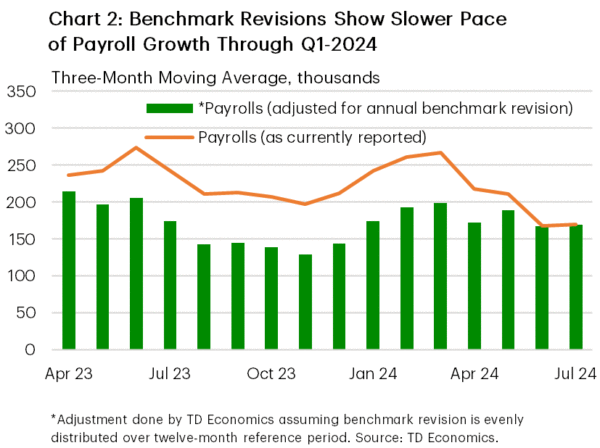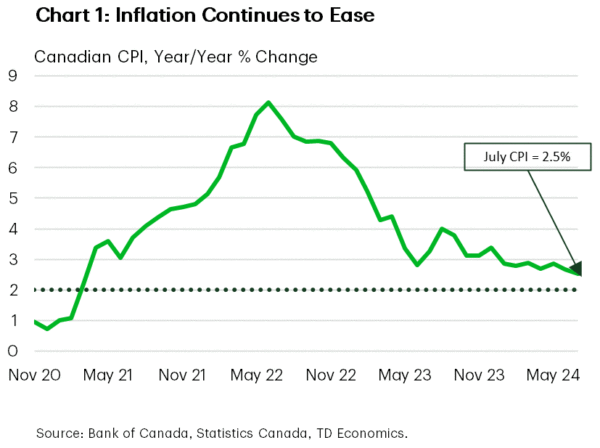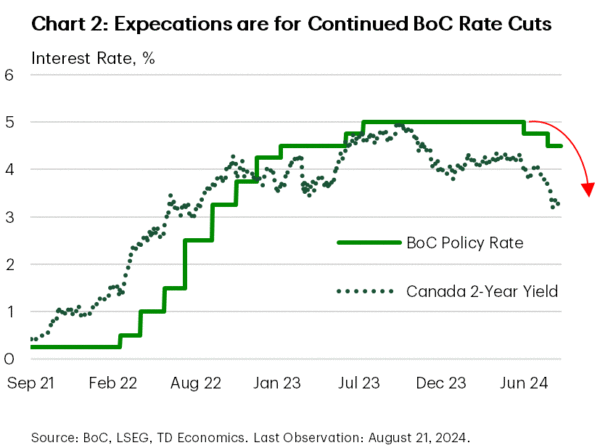U.S. Highlights
- Minutes from the July 30-31 FOMC meeting as well as Chair Powell’s speech at Jackson Hole showed a clear commitment that the FOMC will start cutting rates in September.
- The Fed is likely to start slow, cutting by 25 basis points next month. But any signs of a more abrupt cooling in the labor market will result in a more aggressive pace of rate cuts.
- Adding to evidence of a cooler labor market, annual benchmark revisions showed non-farm employment ended Q1 with less momentum than previously thought.
Canadian Highlights
- Headline inflation continued to decelerate in July, coming in at a palatable 2.5% year-on-year – the lowest reading since early 2021.
- The CNR/CPKC work stoppage made news this week, and the government has sent the parties to final arbitration, which hopefully sees operations return in the coming days.
- Retail sales came in weak for June, reminding us that consumers’ spending power remains limited in the face of high rent and high interest rates.
U.S. – Fed Chair Powell Endorses September Rate Cut
It was a quiet week on the economic data calendar, but there was plenty of Fed communication for market participants to digest. The headliner was Fed Chair Powell’s speech at the annual Jackson Hole Symposium, where the Chairman signaled a clear desire for the FOMC to begin reducing its policy rate at its next meeting in September. The news hardly came as a surprise, particularly coming after the release of the July 30-31 FOMC minutes, which indicated that the “vast majority of participants” supported cutting rates at the next meeting. Though equity markets see-sawed through most of the week, a clear commitment from Powell that the Fed will soon start loosening its policy stance helped to fuel a late-week rally, with the S&P 500 looking to end the week up 1.3%. Bond yields across the curve were lower by 10-15 basis-points (bps) on the week, with the 10-year Treasury sitting at 3.8% at the time of writing.
Two years ago, Chair Powell delivered a very somber message during his speech at Jackson Hole, stating the Federal Reserve will do “whatever it takes to restore price stability” even if that meant “inflicting some economic pain”. At the time, inflation was sitting at a multi-decade high while the labor market had tightened to a degree not seen in recent history. It had become obvious that policymakers had fallen well behind the curve and were scrambling to play catch-up. While many feared that the FOMC’s swift actions of quickly raising the policy rate (Chart 1) risked overtightening and potentially tipping the economy into a recession, the downturn never materialized.
During his speech Friday morning, Chair Powell acknowledged the progress the Fed has made over the past two years, specifically noting that the upside risks to inflation have diminished while the downside risks to employment have increased. While Powell offered nothing in terms of the speed of adjustment, other policymakers speaking this week highlighted the importance of a “gradual” and “methodical” approach to loosening policy, which supports a 25 basis point cut in September. However, Powell also emphasized that the FOMC “does not seek or welcome any further cooling in the labor market”, which suggests the next several employment reports will be critical in determining the future path of the policy rate.
Fears of a further cooling in the labor market aren’t completely unfounded. Earlier this week, the BLS released its preliminary annual benchmark revisions for non-farm employment, which showed that payrolls were 818 thousand less over the twelve-month period ending in March 2024 – the largest downward adjustment since 2009. This implies that job gains likely averaged closer to 174 thousand per-month over the reference period, as opposed to the 242 thousand currently reported (Chart 2).
Even after incorporating the revisions, there’s nothing yet to suggest that the labor market has overcorrected. This is why we feel that the FOMC is likely to opt for a more gradual approach in the beginning. However, it is clear that policymakers have become hypervigilant of the labor market and any further signs of cooling is likely to bring a more aggressive path for rate cuts.
Canada – The Door is Wide Open for More Rate Cuts
Fed Chair Powell’s Jackson Hole speech might have been the headliner for financial markets this week, but Canadian economic data were an exciting opening act. Canadian Consumer Price Index (CPI) inflation confirmed that the Bank of Canada (BoC) can keep up its rate cutting pace. At the same time, retail sales showed that consumer spending remains constrained in the face of still high interest rates. The CNR/CPKC labour dispute is heading for binding arbitration, which will hopefully limit the downside risk to near-term economic growth. All this combined to anchor expectations that the BoC will cut its overnight rate by 25 basis points at its announcement in two weeks.
Headline inflation continued to decelerate in July, coming in at a palatable 2.5% year-on-year (y/y). That is the lowest reading since early 2021 and marks the seventh month in a row that inflation has fallen within the BoC’s 1% to 3% range (Chart 1). Even more convincing is that inflation excluding the impact of mortgage interest costs has been below the 2% target rate for nearly all of 2024. Outside of structural factors facing Canada’s housing sector, inflation is back to normal.
Looking forward, inflation’s underlying details point to continued improvement over the remainder of the summer. The base-effects – the impact of last summer’s price increases dropping out of the annual inflation figures – that pushed July’s inflation rate lower, will support a continuation of the recent disinflationary trend. Furthermore, core inflation rates have continued to ease (2.6% y/y for the average of the BoC’s core rates), which points to improved underlying inflationary dynamics. The only caveat is that there has been a noticeable upturn in the three-month annualized pace of inflation, having gone from 1.4% in March to 2.7% in July. This increase has raised our eyebrows, but rather than signaling a re-emergence of future inflation, it points to inflation settling around the mid-2% level in 2025.
Also making headlines was the announcement of the CNR/CPKC work stoppage. On Thursday, nine thousand workers were locked out, halting rail traffic for goods, ranging from fertilizer to hazardous chemicals. Approximately $1 billion a day is transported over rail lines, while thousands of transit users saw their main commuting method unavailable. As of Friday, the government has sent the dispute to final arbitration, which should result in (but doesn’t guarantee) operations going back to normal in the coming days.
Retail sales, on the other hand, reminded us that consumers are under pressure. There was a noticeable drop-off in spending in June, which has been a trend for consumers facing tough spending choices in the face of rising rents and higher mortgage payments. All this combines to make a convincing case for the BoC to keep cutting its policy rate. With the door to rate cuts wide open, we expect the central bank will proceed with cuts at each of its next three remaining decisions over 2024 (Chart 2).















